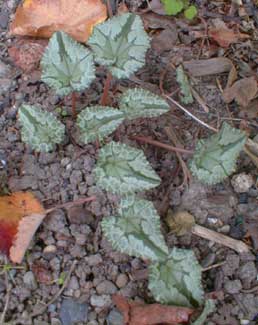
Bowles' Apollo
Silver-leafed Cyclamen
"Arise!" commands my guardian angel.
"Life will soothe
Your heart with cyclamens,
that come as wormwood's sequel."
-Mikhail Konstantinovich Scherbakov,
b.1963
b.1963
This "Bowles' Apollo" Cyclamen hederifolium ssp hederifolium var hederifolium had a bit of trouble getting established in our garden. I bought it as an overpriced year-old seedling, & its first autumn in our cyclamen bed, a cat scraped off all its leaves & took a big poopy dump on top of it. It produced no further leaves for that year, & I worried it was dead. But I learned long ago never to count a cyclamen out, so did not disturb its location. By its third year it was leafing well though still kind of small & definitely slow to establish.
There is considerable variation among the cyclamens designated "Bowles Apollo Group" or "Bowles Apollo Strain." Although most Apollos are actually more pewtery than silver, they are nevertheless designated Silver-leaf, as well as Pattern-leaf. The leaves of our Apollo have a green silhouette of an arrow in the center, with a pewter shield at the center of the silhouette, & is surrounded by silverier pewter mottling to the deckled edges of the slim heart or arrow-shaped leaves. The shield within a silhouette of an arrow or tree is called "double shield" pattern.
The unique features of the Apollo Group specimens are the double shield, & the fact that the arrow-silhouette reaches through the silvery mottling to the very tip of the leaf, giving the impression of a narrow stripe. There is occasionally an additional trait of a pinkish flush to the leaves. These leaves are extremely gorgeous even when not in bloom, & if seen amidst other showy-leafed pattern-leaf varieties, Apollos are almost always showiest of all.
The first specimens ever to show this specific pattern were spotted by Gerard Parker in the garden of E. A. Bowles at Myddleton House, amidst less ornately leafed C. hederifolium, & this specimen was the first ever called "Apollo." Because seedlings are not quite identical one to the next, the resulting strain became a "Group," but so long as it has that separating zone around the arrowhead pattern, & the arrow point terminating right at the leaf edge, it remains an Apollo.
Flower color is variable too, including "Alba Apollo Group" with white flowers, & Pink Apollos in sundry shades from pale shell-pink to a deeper rosier pink but not as dark as magenta that I've seen.
Ours has decidedly pink blossoms which would ordinarily appear early in September (in some gardens, the blooms may appear as early as August) without a single leaf yet visible, though our young specimen has bloomed simultaneously with or immediately after the appearance of juvenile leaves. It will probably behave like "most" Apollos & C. hederifoliums generally, flowering before it leafs, when it has developed a more substantial tuber, although narrowly predictable behavior is not inevitable with this variable with the Apollo Group or with the species generally.
Juvenile leaves appear by August's end, then build their size & numbers in earnest throughout October. There is sometimes a tapering off or a complete interuption of blooms as the tuber concentrates on the rapid growth of leaves, then it produces more blooms through the remainder of October. Flowering is generally completed by November, but the mats of colorful leaves persist through the whole of winter, right up to March.
Continue to
Cyclamen hederifolium ssp hederifolium 'Silver Cloud'
Cordate Silverleaf (Pewter Group) Rose Pink